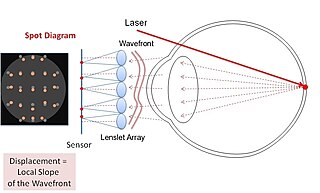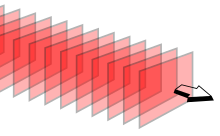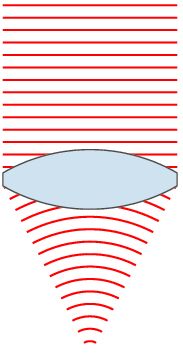
Diffraction is the interference or bending of waves around the corners of an obstacle or through an aperture into the region of geometrical shadow of the obstacle/aperture. The diffracting object or aperture effectively becomes a secondary source of the propagating wave. Italian scientist Francesco Maria Grimaldi coined the word diffraction and was the first to record accurate observations of the phenomenon in 1660.

The Huygens–Fresnel principle states that every point on a wavefront is itself the source of spherical wavelets, and the secondary wavelets emanating from different points mutually interfere. The sum of these spherical wavelets forms a new wavefront. As such, the Huygens-Fresnel principle is a method of analysis applied to problems of luminous wave propagation both in the far-field limit and in near-field diffraction as well as reflection.

A lens is a transmissive optical device that focuses or disperses a light beam by means of refraction. A simple lens consists of a single piece of transparent material, while a compound lens consists of several simple lenses (elements), usually arranged along a common axis. Lenses are made from materials such as glass or plastic and are ground, polished, or molded to the required shape. A lens can focus light to form an image, unlike a prism, which refracts light without focusing. Devices that similarly focus or disperse waves and radiation other than visible light are also called "lenses", such as microwave lenses, electron lenses, acoustic lenses, or explosive lenses.

Optics is the branch of physics that studies the behaviour and properties of light, including its interactions with matter and the construction of instruments that use or detect it. Optics usually describes the behaviour of visible, ultraviolet, and infrared light. Because light is an electromagnetic wave, other forms of electromagnetic radiation such as X-rays, microwaves, and radio waves exhibit similar properties.

Fermat's principle, also known as the principle of least time, is the link between ray optics and wave optics. Fermat's principle states that the path taken by a ray between two given points is the path that can be traveled in the least time.

Interferometry is a technique which uses the interference of superimposed waves to extract information. Interferometry typically uses electromagnetic waves and is an important investigative technique in the fields of astronomy, fiber optics, engineering metrology, optical metrology, oceanography, seismology, spectroscopy, quantum mechanics, nuclear and particle physics, plasma physics, biomolecular interactions, surface profiling, microfluidics, mechanical stress/strain measurement, velocimetry, optometry, and making holograms.

Adaptive optics (AO) is a technique of precisely deforming a mirror in order to compensate for light distortion. It is used in astronomical telescopes and laser communication systems to remove the effects of atmospheric distortion, in microscopy, optical fabrication and in retinal imaging systems to reduce optical aberrations. Adaptive optics works by measuring the distortions in a wavefront and compensating for them with a device that corrects those errors such as a deformable mirror or a liquid crystal array.

The point spread function (PSF) describes the response of a focused optical imaging system to a point source or point object. A more general term for the PSF is the system's impulse response; the PSF is the impulse response or impulse response function (IRF) of a focused optical imaging system. The PSF in many contexts can be thought of as the extended blob in an image that represents a single point object, that is considered as a spatial impulse. In functional terms, it is the spatial domain version of the optical transfer function (OTF) of an imaging system. It is a useful concept in Fourier optics, astronomical imaging, medical imaging, electron microscopy and other imaging techniques such as 3D microscopy and fluorescence microscopy.

An aspheric lens or asphere is a lens whose surface profiles are not portions of a sphere or cylinder. In photography, a lens assembly that includes an aspheric element is often called an aspherical lens.

In optics, a ray is an idealized geometrical model of light or other electromagnetic radiation, obtained by choosing a curve that is perpendicular to the wavefronts of the actual light, and that points in the direction of energy flow. Rays are used to model the propagation of light through an optical system, by dividing the real light field up into discrete rays that can be computationally propagated through the system by the techniques of ray tracing. This allows even very complex optical systems to be analyzed mathematically or simulated by computer. Ray tracing uses approximate solutions to Maxwell's equations that are valid as long as the light waves propagate through and around objects whose dimensions are much greater than the light's wavelength. Ray optics or geometrical optics does not describe phenomena such as diffraction, which require wave optics theory. Some wave phenomena such as interference can be modeled in limited circumstances by adding phase to the ray model.
In optics, piston is the mean value of a wavefront or phase profile across the pupil of an optical system. The piston coefficient is typically expressed in wavelengths of light at a particular wavelength. Its main use is in curve-fitting wavefronts with Cartesian polynomials or Zernike polynomials.

A Shack–Hartmannwavefront sensor (SHWFS) is an optical instrument used for characterizing an imaging system. It is a wavefront sensor commonly used in adaptive optics systems. It consists of an array of lenses of the same focal length. Each is focused onto a photon sensor. If the sensor is placed at the geometric focal plane of the lenslet, and is uniformly illuminated, then, the integrated gradient of the wavefront across the lenslet is proportional to the displacement of the centroid. Consequently, any phase aberration can be approximated by a set of discrete tilts. By sampling the wavefront with an array of lenslets, all of these local tilts can be measured and the whole wavefront reconstructed. Since only tilts are measured the Shack–Hartmann cannot detect discontinuous steps in the wavefront.
A wavefront curvature sensor is a device for measuring the aberrations of an optical wavefront. Like a Shack–Hartmann wavefront sensor it uses an array of small lenses to focus the wavefront into an array of spots. Unlike the Shack-Hartmann, which measures the position of the spots, the curvature sensor measures the intensity on either side of the focal plane. If a wavefront has a phase curvature, it will alter the position of the focal spot along the axis of the beam, thus by measuring the relative intensities in two places the curvature can be deduced.
In physics, ray tracing is a method for calculating the path of waves or particles through a system with regions of varying propagation velocity, absorption characteristics, and reflecting surfaces. Under these circumstances, wavefronts may bend, change direction, or reflect off surfaces, complicating analysis. Ray tracing solves the problem by repeatedly advancing idealized narrow beams called rays through the medium by discrete amounts. Simple problems can be analyzed by propagating a few rays using simple mathematics. More detailed analysis can be performed by using a computer to propagate many rays.
A common-path interferometer is a class of interferometers in which the reference beam and sample beams travel along the same path. Examples include the Sagnac interferometer, Zernike phase-contrast interferometer, and the point diffraction interferometer. A common-path interferometer is generally more robust to environmental vibrations than a "double-path interferometer" such as the Michelson interferometer or the Mach–Zehnder interferometer. Although travelling along the same path, the reference and sample beams may travel along opposite directions, or they may travel along the same direction but with the same or different polarization.
The eye, like any other optical system, suffers from a number of specific optical aberrations. The optical quality of the eye is limited by optical aberrations, diffraction and scatter. Correction of spherocylindrical refractive errors has been possible for nearly two centuries following Airy's development of methods to measure and correct ocular astigmatism. It has only recently become possible to measure the aberrations of the eye and with the advent of refractive surgery it might be possible to correct certain types of irregular astigmatism.
The pupil function or aperture function describes how a light wave is affected upon transmission through an optical imaging system such as a camera, microscope, or the human eye. More specifically, it is a complex function of the position in the pupil or aperture that indicates the relative change in amplitude and phase of the light wave. Sometimes this function is referred to as the generalized pupil function, in which case pupil function only indicates whether light is transmitted or not. Imperfections in the optics typically have a direct effect on the pupil function, it is therefore an important tool to study optical imaging systems and their performance.

Treatise on Light: In Which Are Explained the Causes of That Which Occurs in Reflection & Refraction is a book written by Dutch polymath Christiaan Huygens that was published in French in 1690. The book describes Huygens's conception of the nature of light propagation which makes it possible to explain the laws of geometrical optics shown in Descartes's Dioptrique, which Huygens aimed to replace.
Walter Thompson Welford was a British physicist with expertise in optics.

Huygens principle of double refraction, named after Dutch physicist Christiaan Huygens, explains the phenomenon of double refraction observed in uniaxial anisotropic material such as calcite. When unpolarized light propagates in such materials, it splits into two different rays, known as ordinary and extraordinary rays. The principle states that every point on the wavefront of birefringent material produces two types of wavefronts or wavelets: spherical wavefronts and ellipsoidal wavefronts. These secondary wavelets, originating from different points, interact and interfere with each other. As a result, the new wavefront is formed by the superposition of these wavelets.















